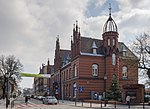
Back Gnesen ALS Gniezno AN جنازنة Arabic جنيزنو ARZ Gniezno AST Qnezno Azerbaijani قینیزنا AZB Гнезна (Польшча) Byelorussian Гнезна (Польшча) BE-X-OLD Гнезно Bulgarian
Gniezno | |
|---|---|
| Royal Capital City of Gniezno Stołeczne Królewskie Miasto Gniezno | |
| |
| Coordinates: 52°32′09″N 17°35′45″E / 52.53583°N 17.59583°E | |
| Country | |
| Voivodeship | |
| County | Gniezno |
| Gmina | Gniezno (urban gmina) |
| Established | 8th-10th century |
| City rights | 1239 |
| Government | |
| • City mayor | Michał Powałowski (PO) |
| Area | |
| • Total | 49 km2 (19 sq mi) |
| Population (31 December 2021) | |
| • Total | 66,769 |
| Time zone | UTC+1 (CET) |
| • Summer (DST) | UTC+2 (CEST) |
| Postal code | 62–200 to 62–210 |
| Area code | +48 61 |
| Car plates | PGN |
| Climate | Dfb |
| Highways | |
| National roads | |
| Website | http://www.Gniezno.eu |
Gniezno ([ˈɡɲɛznɔ] ; Latin: Gnesna) is a city in central-western Poland, about 50 kilometres (31 miles) east of Poznań. Its population in 2021 was 66,769,[1] making it the sixth-largest city in the Greater Poland Voivodeship. One of the Piast dynasty's chief cities, it was the first historical capital of Poland in the 10th century and early 11th century,[2] and it was mentioned in 10th-century sources, possibly including the Dagome Iudex, as the capital of Piast Poland.
Gniezno is the seat of the Roman Catholic Archdiocese of Gniezno, the country's oldest archdiocese, founded in 1000, and its archbishop is the primate of Poland, making the city the country's ecclesiastical capital. The city is the administrative seat of Gniezno County (powiat).
- ^ a b "Local Data Bank". Statistics Poland. Retrieved 15 August 2022. Data for territorial unit 3003011.
- ^ "Gniezno". Encyklopedia PWN (in Polish). Retrieved 28 February 2020.







